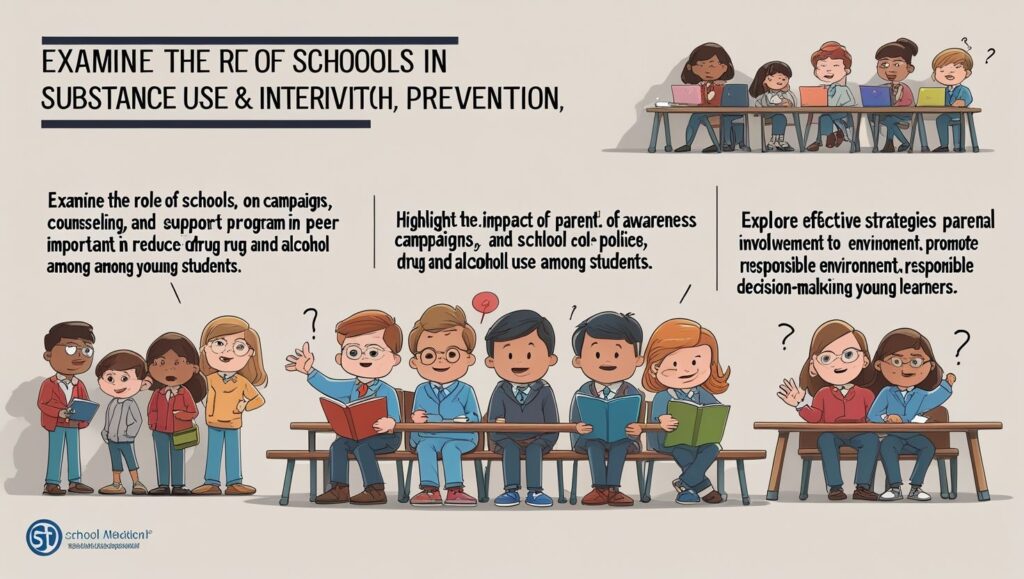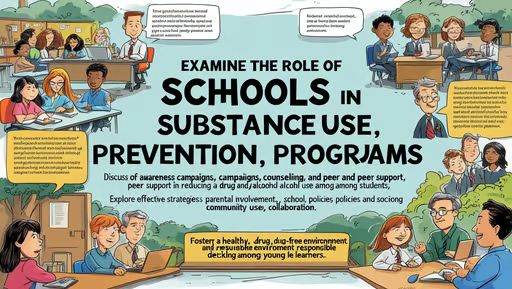Substance Use Prevention in Schools, Substance use among adolescents remains a significant public health concern, with long-term consequences for physical, mental, and social well-being. Schools play a pivotal role in preventing substance use by providing education, fostering supportive environments, and promoting healthy decision-making. Effective prevention strategies in schools are essential to reduce the prevalence of substance use and its associated risks.
The Importance of School-Based Prevention Programs
Schools are ideal settings for substance use prevention because they reach a large population of young people during a critical developmental period. Adolescence is a time of exploration and vulnerability, making it essential to equip students with the knowledge and skills to resist peer pressure and make informed choices. Research shows that early intervention can delay or prevent the initiation of substance use, reducing the likelihood of addiction and other negative outcomes (National Institute on Drug Abuse [NIDA], 2020).
Key Components of Effective Prevention Programs
- Education and Awareness: Comprehensive substance use education should be integrated into the school curriculum. This includes teaching students about the risks of alcohol, tobacco, and illicit drugs, as well as the impact of substance use on brain development and overall health. Evidence-based programs, such as the LifeSkills Training program, have been shown to reduce substance use by improving students’ resistance skills and self-efficacy (Botvin & Griffin, 2004).
- Skill Development: Prevention programs should focus on building life skills, such as communication, decision-making, and stress management. These skills empower students to navigate challenging situations and resist peer pressure. For example, social-emotional learning (SEL) programs have been effective in promoting positive behaviors and reducing risky behaviors, including substance use (Durlak et al., 2011).
- Positive School Climate: A supportive and inclusive school environment can reduce the likelihood of substance use. Schools should promote positive relationships between students and staff, encourage extracurricular activities, and implement anti-bullying policies. A sense of belonging and connectedness to school has been linked to lower rates of substance use (Resnick et al., 1997).
- Parental Involvement: Engaging parents in prevention efforts is crucial. Schools can offer workshops and resources to help parents communicate with their children about substance use and set clear expectations. Family-based prevention programs, such as Strengthening Families, have demonstrated success in reducing substance use by improving family dynamics and parenting skills (Kumpfer et al., 2002).
- Early Identification and Intervention: Schools should have systems in place to identify students at risk of substance use and provide timely interventions. This may include counseling services, referrals to community resources, or peer support programs. Early intervention can prevent the escalation of substance use and address underlying issues, such as mental health concerns (Hawkins et al., 1992).
Challenges and Barriers
Despite the potential of school-based prevention programs, several challenges exist. Limited funding, lack of trained staff, and competing academic priorities can hinder implementation. Additionally, cultural and socioeconomic factors may influence the effectiveness of prevention efforts. Tailoring programs to meet the unique needs of diverse student populations is essential for success.

The Role of Policy and Community Collaboration
Schools cannot address substance use prevention in isolation. Collaboration with community organizations, healthcare providers, and policymakers is critical. Policies that restrict access to substances, such as tobacco and alcohol, can complement school-based efforts. Community-wide initiatives, such as public awareness campaigns and youth engagement programs, can reinforce the messages delivered in schools.
Conclusion
Substance use prevention in schools is a multifaceted endeavor that requires a comprehensive and collaborative approach. By integrating education, skill development, and supportive environments, schools can empower students to make healthy choices and reduce the prevalence of substance use. Continued investment in evidence-based programs and policies is essential to ensure the long-term success of prevention efforts.
References
Botvin, G. J., & Griffin, K. W. (2004). Life skills training: Empirical findings and future directions. Journal of Primary Prevention, 25(2), 211-232.
Durlak, J. A., Weissberg, R. P., Dymnicki, A. B., Taylor, R. D., & Schellinger, K. B. (2011). The impact of enhancing students’ social and emotional learning: A meta-analysis of school-based universal interventions. Child Development, 82(1), 405-432.
Hawkins, J. D., Catalano, R. F., & Miller, J. Y. (1992). Risk and protective factors for alcohol and other drug problems in adolescence and early adulthood: Implications for substance abuse prevention. Psychological Bulletin, 112(1), 64-105.
Kumpfer, K. L., Alvarado, R., & Whiteside, H. O. (2002). Family-based interventions for substance use and misuse prevention. Substance Use & Misuse, 38(11-13), 1759-1787.
National Institute on Drug Abuse. (2020). Preventing drug use among children and adolescents.
Resnick, M. D., Bearman, P. S., Blum, R. W., Bauman, K. E., Harris, K. M., Jones, J., … & Udry, J. R. (1997). Protecting adolescents from harm: Findings from the National Longitudinal Study on Adolescent Health. JAMA, 278(10), 823-832.

5 thoughts on “Substance Use Prevention in Schools”
Comments are closed.